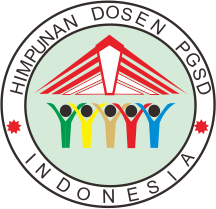THE INFLUENCE OF THE MNEMONIC LEARNING MODEL ON THE LEARNING OUTCOMES OF ARTS, CULTURE, AND CRAFTS (SBDP) IN CLASS IV SDN PANNARA, MAKASSAR CITY
Abstract
ABSTRACT
This study aims to determine whether the mnemonic learning model influences the learning outcomes of arts and crafts (SBdP) for fourth grade students at SDN Pannara, Makassar City. The research method employed was quantitative experimental research with a one-group pretest-posttest design, and the subjects were fourth-grade elementary school students with collage-related two-dimensional expression work material. This study employs research test instruments, observation sheets, and documentation. In this study, descriptive statistical analysis and inferential statistical analysis were used to analyze the data. Fourth-grade students of SDN Pannara Makassar City whose learning outcomes were enhanced by the application of the mnemonic learning model, as demonstrated by the study's findings. This is demonstrated by testing the hypothesis with the t-test and the test results, namely a significance of 0.000 0,000 < α 0,05 which means that H1 is accepted and H0 is rejected. Where H1 asserts that SBdP learning outcomes for fourth-grade students at SDN Pannara have improved because of the use of the mnemonic learning model. While H0 claimed there was no improvement in SBdP learning outcomes for fourth-grade students at SDN Pannara because of the use of the mnemonic learning model, this study found otherwise. The average student score, which ranges from 30.67 on the pre-test to 90.95 on the post-test, further demonstrates this point. The use of the mnemonic learning model improved the learning outcomes of fourth grade students of SDN Pannara in Makassar City. Therefore, it is recommended that teachers, especially of SBdP subjects, consider using the mnemonic learning model in SBdP learning to make the teaching and learning process more effective, enjoyable, and engaging.
Keywords
References
REFERENCES
[1] S. Arikunto, Dasar-dasar Evaluasi Pendidikan. Jakarta: PT. Bumi Aksara, 2012.
[2] Aunurrahman, Belajar dan Pembelajaran. Bandung: Alfabeta, 2010.
[3] R. W. Dahar, Teori-teori Belajar. Jakarta: Erlangga, 1996.
[4] L. Mareza, “Cultural Art And Craft Education As A General Intervention Strategy For Special Needs Children,” Scholaria, vol. 7, no. 1, pp. 35–38, 2017.
[5] D. Prastyo, A. Anturi, and A. M. Fanny, “Perbedaan Hasil Belajar Mahasiswa PGSD UNIPA Surabaya dengan Model Mnemonik pada Materi Peta, Atlas dan Globe Ditinjau dari Gaya Belajar Audio, Visual dan Kinestetik,” TRIHAYU J. Pendidik. Ke-SD-an, vol. 4, no. 1, pp. 199–207, 2017, doi: https://doi.org/10.30738/trihayu.v4i1.2117.
[6] A. Stine, J.M., Meningkatkan Daya Ingat Anda dengan Menggunakan Seluruh Otak Anda. Jakarta: Gramedia, 2002.
[7] R. L. dkk Atkinson, Pengantar Psikologi Edisi Kesebelas, Jilid satu. Batam: Interaksasa, 1997.
[8] Y. A. Lestari, “Metode Mnemonik untuk Mengingat Dua Belas Nervus Cranialis pada Mahasiswa Tingkat II Akper Kosgoro Mojokerto,” Universitas Sebelas Maret Surakarta, 2010.
[9] L. Rekhamandia, “Pengaruh Penerapan Model Pembelajaran Mnemonik Terhadap Hasil Belajar Siswa,” Universitas Pendidikan Indonesia, Bandung, 2014.
[10] L. M. Prasetyo, B., & Jannah, Metode Penelitian Kuantitatif (Kelima). Jakarta: Raja Grafindo Persada, 2010.
[11] M. R. S. Jalal, Hasanudin Kasim, Akhiruddin and H. Sriwahyuni, “The Impact of Socio-Economic Status on Teachers ’ Performance in SMP Negeri 2 Parigi Gowa Regency,” IJOLEH Int. J. Educ. Humanit., vol. 2, no. 1, pp. 75–84, 2023, doi: https://doi.org/10.56314/ijoleh.v2i1.
[12] Y. Darusman and W. Herwina, Pembelajaran Mnemonik. Bandung: CV Buku Langka Indonesia, 2018. [Online]. Available: http://repositori.unsil.ac.id/2221/1/PEMBELAJARAN MNEMONIK.pdf
[13] M. H. Tsai, L. Y. Chang, H. C. Chen, and C. L. Lin, “Effects of key-image mnemonics on Chinese instruction for first-grade students’ achievement and interest toward Chinese learning,” Int. J. Educ. Res., vol. 109, no. October 2020, p. 101856, 2021, doi: 10.1016/j.ijer.2021.101856.
[14] T. Tarmilia, F. Fadjaritha, I. W. Istiqomah, E. Purwandari, and F. D. Hutagalung, “Learning and Memory of Early Childhood Tahfiz Quran: A Systematic Review,” J. Obs. J. Pendidik. Anak Usia Dini, vol. 6, no. 6, pp. 5913–5922, 2022, doi: 10.31004/obsesi.v6i6.1707.
[15] M. Samsudin, “Faktor-Faktor yang Memengaruhi Belajar,” Eduprof Islam. Educ. J., vol. 2, no. 2, pp. 162–186, 2020, doi: 10.47453/eduprof.v2i2.38.
DOI: 10.30595/dinamika.v16i1.19248
Copyright (c) 2024 Cayati Cayati

This work is licensed under a Creative Commons Attribution 4.0 International License.
ISSN: 2655-870X
|
Visitors













